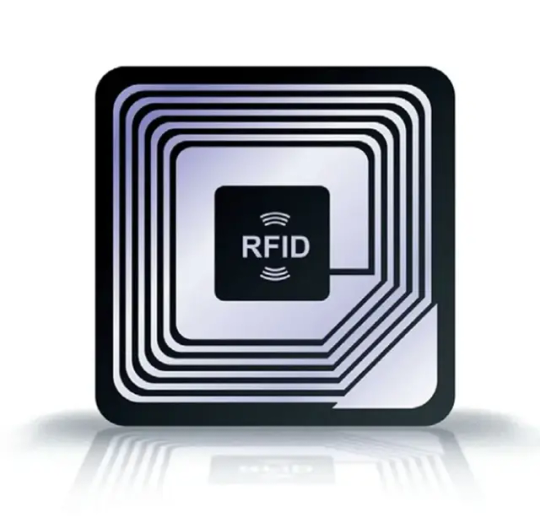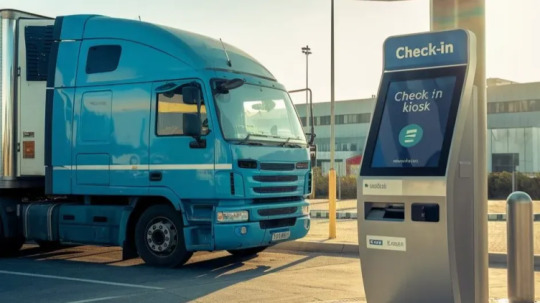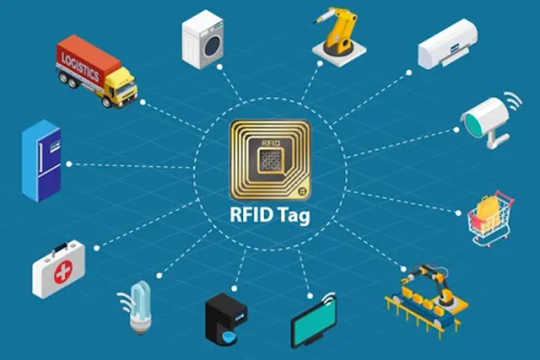#RFIDTechnology
Explore tagged Tumblr posts
Text
Chip-less RFID Market Future Trends Driving Next-Gen Contactless Tracking and Smart Inventory Systems
As global industries move toward digital transformation and automation, the chip-less RFID market is gaining unprecedented attention. Unlike traditional RFID systems, chip-less RFID operates without silicon chips, making it more cost-effective, flexible, and suitable for mass applications. With a focus on sustainability, efficiency, and intelligent data capture, the market is projected to undergo dynamic shifts in the coming years. These future trends are shaping how businesses, governments, and logistics sectors handle tracking, authentication, and inventory management.

Rise in Cost-Effective and Eco-Friendly Solutions
One of the most significant future trends driving the chip-less RFID market is the increasing demand for low-cost identification solutions. Traditional RFID systems come with silicon chips, which make them more expensive and harder to recycle. In contrast, chip-less systems use printable electronics and conductive materials, making them a greener and more economical option. As environmental regulations become stricter, industries are actively seeking alternatives that reduce e-waste and lower carbon footprints, leading to accelerated adoption of chip-less RFID technologies.
Integration with Smart Supply Chain Ecosystems
The convergence of chip-less RFID with smart logistics and supply chain management is set to become a game-changer. Future trends indicate that these systems will play a pivotal role in enhancing transparency, reducing errors, and speeding up inventory processes. By enabling real-time tracking without the need for batteries or complex infrastructure, chip-less RFID tags offer unmatched scalability for warehouse operations, retail chains, and shipping networks. This integration will be particularly beneficial for businesses looking to implement Industry 4.0 and IoT-enabled supply chain strategies.
Advancements in Printed and Flexible Electronics
Technological innovation in printed electronics is one of the key enablers behind the growth of chip-less RFID. Future trends point toward the expansion of ink-based RFID tags that can be printed on paper, plastic, fabric, or even directly on products. This breakthrough opens new possibilities for applications in textiles, packaging, and healthcare. The growing availability of printable conductive inks and materials is also expected to drive mass production, enabling manufacturers to produce tags at scale and embed them seamlessly into various surfaces.
Increased Adoption Across Healthcare and Pharmaceuticals
The healthcare sector is rapidly emerging as a key adopter of chip-less RFID technology. Hospitals, clinics, and pharmaceutical companies are exploring its use in tracking medical supplies, patient identification, and medication monitoring. Unlike barcodes, chip-less RFID tags can be read without direct line-of-sight, offering faster and more accurate data capture. In the future, we can expect widespread use of chip-less systems for sterile environments, vaccine tracking, and ensuring authenticity in drug distribution chains.
Enhanced Security and Anti-Counterfeiting Measures
Another future trend gaining traction is the use of chip-less RFID for anti-counterfeiting and brand protection. High-end consumer goods, electronics, and luxury products are increasingly vulnerable to counterfeit threats. Chip-less RFID technology, when combined with cryptographic features and unique identification patterns, can offer a secure and tamper-proof solution. As technology advances, the ability to integrate invisible RFID tags into product packaging will become a powerful deterrent against counterfeiting, giving manufacturers and consumers greater confidence in product authenticity.
Government and Transportation Sector Deployment
Governments and public infrastructure agencies are beginning to recognize the potential of chip-less RFID in areas such as toll collection, vehicle identification, public transportation, and border security. With its non-intrusive design and passive nature, the technology is ideal for large-scale identification systems. Future trends indicate expanded use in national ID systems, e-passports, and smart city initiatives. This transition will be supported by improved reader infrastructure and wider standardization, making chip-less RFID a preferred choice for public sector deployments.
Shift Toward Consumer-Driven Applications
As the technology matures, chip-less RFID will move beyond industrial and enterprise-level usage toward more consumer-focused applications. From smart packaging in supermarkets to contactless ticketing at events, the possibilities are endless. The retail sector, in particular, stands to benefit from innovations that allow for instant checkout, interactive product experiences, and precise inventory tracking. With smartphones and connected devices becoming more prevalent, future chip-less RFID systems will likely be compatible with mobile readers, driving broader accessibility and convenience for end users.
Final Thoughts
The future of the chip-less RFID market is brimming with potential as the world demands faster, smarter, and more sustainable identification solutions. With ongoing innovation in materials, manufacturing, and integration techniques, chip-less RFID is expected to become a cornerstone of next-generation data collection systems. Its ability to seamlessly blend with smart environments, improve operational efficiency, and reduce costs makes it a vital technology for businesses aiming to thrive in the digital economy. As adoption accelerates, industries that embrace these future trends will be better positioned to capitalize on the shift toward contactless, intelligent ecosystems.
0 notes
Text
U.S. RFID Tags: Driving Efficiency in Global Freight and Logistics
RFID tags gaining popularity in retail and manufacturing industries Radio frequency identification (RFID) technology has been around for decades but its use has expanded significantly in the United States in recent years. More companies are implementing RFID systems to track goods and assets throughout the supply chain with the goal of boosting efficiency and reducing costs. U.S.RFID Tags uses radio waves to automatically identify objects. An RFID tag is attached to or incorporated into a product. The tag contains an antenna and a microchip that can be read by an RFID reader from several feet away. No line of sight is required and tags can even be read through packaging materials. When triggered by a reader's radio signal, the tag transmits a unique product number, serial number or other identifying information back to the reader. U.S. RFID Tags - https://www.patreon.com/posts/u-s-rfid-tags-in-128345816
0 notes
Text
RFID Market Growth Opportunities: Size and Share Projections for 2032

Radio Frequency Identification (RFID) technology has become a cornerstone of modern asset management, inventory tracking, and identification systems across numerous industries. By using radio waves to automatically identify and track tags attached to objects, RFID offers unparalleled benefits in efficiency and data accuracy. The RFID market is witnessing rapid growth, driven by increasing demand for smart and connected solutions.
Get a Free Sample Report - https://www.skyquestt.com/sample-request/rfid-market
Market Size and Growth Projections
In 2024, the global RFID market was valued at USD 20.8 billion and is expected to grow significantly in the coming years. Projections indicate that the market will reach USD 64.07 billion by 2032, reflecting a compound annual growth rate (CAGR) of 15.1% from 2025 to 2032. The increase in market size is a result of widespread adoption of RFID solutions across diverse sectors, including retail, healthcare, logistics, and manufacturing.
The RFID market's expansion is particularly strong in retail and logistics, where the need for real-time inventory tracking and improved operational efficiency is paramount. Additionally, industries such as healthcare are adopting RFID for patient and asset tracking, further contributing to the market's growth.
Key Growth Drivers
Several factors are propelling the growth of the RFID market:
- Regulatory Compliance: Increasing regulations in industries such as healthcare, pharmaceuticals, and food safety are driving the adoption of RFID for traceability and compliance purposes. RFID technology helps ensure that goods meet safety standards and regulatory requirements, especially in sectors that are heavily regulated.
- Supply Chain Optimization: RFID technology enhances supply chain efficiency by offering real-time tracking of goods and assets, reducing human errors, and optimizing inventory management. This leads to cost savings, better forecasting, and improved delivery timelines.
- E-commerce and Retail Growth: The rapid rise of e-commerce has increased the need for efficient inventory and warehouse management systems. RFID offers real-time data on product movements and stock levels, making it a valuable tool for businesses in the retail and e-commerce sectors.
- Technological Advancements: Continued innovation in RFID technology, including the development of smaller, more powerful tags and readers, is driving its adoption. New applications for RFID, such as in contactless payment systems and smart logistics, are further expanding the market.
Make an Inquiry to Address your Specific Business Needs - https://www.skyquestt.com/speak-with-analyst/rfid-market
Market Segmentation
The RFID market is segmented based on frequency, industry application, and region:
- By Frequency: RFID technology is categorized into three main frequencies: Low Frequency (LF), High Frequency (HF), and Ultra High Frequency (UHF). UHF RFID is expected to dominate the market due to its high data transfer speeds and long-range capabilities, making it ideal for applications like inventory management, asset tracking, and logistics.
- By Industry: The RFID market spans several industries, with the largest demand seen in retail, healthcare, manufacturing, transportation, and logistics. Retailers, in particular, are increasingly implementing RFID to manage inventory, improve customer experience, and prevent theft. Healthcare providers are using RFID for tracking medical equipment, patients, and pharmaceuticals to ensure better safety and compliance.
Regional Insights
- North America: North America holds a significant share of the RFID market, driven by the high adoption of RFID technology across retail, healthcare, and logistics sectors. The region’s well-established infrastructure and strong regulatory framework also contribute to the growth of the market.
- Asia Pacific: The Asia Pacific region is expected to experience the highest growth rate during the forecast period. Rapid industrialization, urbanization, and government initiatives to embrace digital technologies are driving RFID adoption in countries like China and India. The growing e-commerce sector and the need for advanced logistics solutions further fuel demand in this region.
- Europe: Europe is another key region for RFID technology, with widespread use in manufacturing and automotive industries. The European Union's emphasis on supply chain efficiency and sustainability is also contributing to market growth.
Take Action Now: Secure Your RFID Market Today - https://www.skyquestt.com/buy-now/rfid-market
Top Competitors in the RFID Market
The RFID market is highly competitive, with several leading companies providing a wide range of products and solutions. Some of the top players in the market include:
- Zebra Technologies: Known for its comprehensive RFID solutions, Zebra Technologies offers a range of RFID printers, scanners, and software. The company’s products are widely used in supply chain management, retail, and healthcare.
- Impinj: Impinj is a leader in RAIN RFID solutions, providing tags, readers, and software designed to deliver high-performance, scalable RFID systems. The company’s products are used in industries such as retail, logistics, and healthcare.
- NXP Semiconductors: A major player in the RFID market, NXP designs RFID chips and solutions for applications across various sectors, including automotive, retail, and smart cities.
- Avery Dennison: Avery Dennison is a global leader in RFID labeling and tagging solutions. The company serves industries such as retail, logistics, and manufacturing, helping businesses streamline their operations through RFID technology.
- HID Global: Specializing in secure identity solutions, HID Global provides RFID tags and readers used in access control, asset tracking, and other applications. The company is a prominent player in the RFID security and authentication sector.
Read RFID Market Report Today - https://www.skyquestt.com/report/rfid-market
The RFID market is poised for substantial growth over the next decade. With advancements in technology and the increasing need for efficient and automated systems across industries, RFID is set to become even more integral to supply chains, retail operations, healthcare systems, and beyond. As more companies realize the value of real-time tracking and data accuracy, the market for RFID solutions will continue to expand, providing new opportunities for innovation and industry transformation.
#RFID#RFIDTechnology#MarketGrowth#SupplyChain#InventoryManagement#SmartTracking#AssetTracking#Ecommerce#RetailTechnology#HealthcareInnovation#LogisticsSolutions#DigitalTransformation#TechInnovation#Industry4_0#RFIDMarket#RFIDTrends#TechnologyTrends#FutureOfTech#Automation#IoT#SmartTech#TechGrowth
0 notes
Text
✨ Revolutionize Jewellery Management with RFID Jewellery Inventory Software! ✨
Tired of manual stock checks and misplaced items? 💍📊 Say hello to RFID Jewellery Inventory Software—the game-changer for jewellery businesses!
✅ Real-time Inventory Tracking ✅ Enhanced Security Against Theft ✅ Faster Stock Audits ✅ Seamless Integration with POS & ERP
Boost efficiency, reduce losses, and manage your jewellery stock effortlessly! 🚀
💎 Ready to upgrade your jewellery business? Learn more today! 🔗 https://www.synergicssolutions.com/rfid-jewellery-inventory-software-transforming-jewellery-businesses
0 notes
Text

The Valuable Benefits of Truck Driver Kiosks
Truck Driver Kiosks Truck drivers are a very crucial part of logistics management in global trade. However, managing the administrative and operational jobs for the truckers at the warehouses, depots, and distribution centers has been such a headache in logistics management for so many years.
A truck driver kiosk is a self-service terminal designed for truck drivers to address all their needs related to check-in, documentation, payment processing etc. Truck driver kiosks transform the logistics domain by streamlining essential tasks, ensure efficiency, reduce downtime and increase overall productivity. Read on for more.
Simplifying Check-In and Documentation One of the key objectives of a truck driver check-in kiosk is to provide easy and fast registration. With conventional systems, truckers entering a warehouse or depot had to stand in line to communicate with warehouse staff. This was time consuming and often went terribly wrong and led to miscommunication.
With a truck driver kiosk, the process is seamless. Drivers can enter their information, scan relevant documents, and receive instructions for loading or unloading through an intuitive touchscreen interface. Many kiosks integrate with RFID scanners and license plate recognition systems so the verification does not have to be input manually. This minimizes waiting time and removes bottlenecks, giving drivers the ability to focus on the efficiency of driving routes.
Enhancing Communication Between Drivers and Operators Effective communication between truckers and the logistics operators is for sure indispensable towards smooth operations. Truck driver kiosks can serve as a central point of communication through which drivers will receive assignments in real-time, schedules and dock locations. Instead of radio communication or face-to-face information flow, all relevant information can be availed through the kiosk.
This streamlined approach reduces miscommunication and ensures that drivers are well-informed about their tasks. Moreover in case any change took place, the kiosk can immediately inform the driver, and he can keep his schedules on track.
Improving Safety and Compliance The trucking industry is among the most safety and regulatory compliance-driven businesses. Truck driver kiosks play a significant role in ensuring that these aspects are addressed as efficiently as possible. In fact, most kiosks allow drivers to complete safety checklists and report vehicle inspections while confirming the status of regulatory compliance.
Truck Driver Kiosks For example, a kiosk can require drivers to upload or scan their driving licenses, permits, and health certifications. All this information is safely stored and accessible to operators for audit purposes. Kiosks minimize the potential of non-compliance while maintaining a safe working environment for the drivers and warehouse workers.
Supporting Contactless and Cashless Transactions With the rise of digital technology, the world is shifting toward contactless and cashless transactions, and truck driver kiosks are some of the top representatives of this trend. Drivers use these kiosks to pay for tolls, fuel, parking, and other similar services without dealing with a single piece of cash.
Kiosks now come with digital payment systems that, in return, accept credit cards and even mobile wallets as well as fleet payment solutions for the ease and convenience of drivers. It not only speeds up the process of transactions but also puts a limit on the amount the driver needs to carry around, enhancing security.
Reducing Administrative Burdens for Operators Indeed, for logistics operators, controlling the trucking and drivers can become a cumbersome activity. This is where truck driver kiosks offer relief, as they automate all administrative responsibilities like record-keeping, data entry, and scheduling. These kiosks can easily interact with WMS and ERP platforms to keep all data synchronized in real time.
This automation minimizes human errors and frees the staff for more valuable activities, such as managing the inventory and service to the customer. Operational efficiency without the accompanying administrative overheads can thus lead to significant cost savings.
Enhancing Driver Satisfaction The trucking profession remains notorious for long hours on the road, tight schedules, and physically demanding work. Kiosks like these that interact with truck drivers solve some of these issues by providing a more user-friendly experience for drivers.
The kiosks might as well be used by those drivers to complete the tasks without having to stand in long queues or navigate complicated manual processes. Most of these kiosks are equipped with ergonomic features, multilingual support, and easy interfaces. They enable drivers of different cultural backgrounds to use the machines comfortably.
Truck Driver Kiosks Happy drivers are more likely to stick with their organizations. Raised satisfaction might also result in improved performance, reduced conflicts, and low fluctuation rates in an industry where retaining drivers has remained a challenge.
Scalability and Versatility Truck driver kiosks are highly scalable, so they can be well-placed for a broad distribution of applications across the logistics industry. Be it small regional warehouses or large distribution hubs, truck driver kiosks can be configured to meet specific operational requirements in every place.
For instance, a truck-stop kiosk might highlight payment facilitation and route guidance. Whereas a kiosk at a distribution center might focus more on checking in, writing information to the rolls and safety checks. This flexibility makes truck driver kiosks a must-have device for all kinds of logistics applications.
Environmental and Operational Sustainability Truck driver kiosks, in the quest for sustainability, greatly contribute to logistics operations; one area being streamlined is the documentation aspect of trucking. Sustainability in logistics involves reducing paper-based documentation and the minutes spent idling on vehicles waiting in line to check in.
The truck driver kiosks also reduce fuel consumption through efficient process handling and minimization of delays thus increasing environmental benefits. Truck driver kiosks keep companies on the firm path to achieving their sustainability objectives, similar to other corporate responsibility efforts.
Conclusion Truck driver kiosks are changing the face of the logistics industry by streamlining operations, enhancing driver satisfaction, and reducing administrative burdens. Automation of key processes like check-ins, documentation, and payments eliminates much of the hassle and ensures maximum down-to-earth time for the drivers and operators.
Their scalability, versatility and orientation towards the modern technological innovations make them a very good investment for those businesses seeking to optimize their logistics operations. As the industry continues to evolve, truck driver kiosks are sure to be a fundamental game-changer in the future of logistics management as well.
Truck driver kiosks investments do not just improve operational efficiency but also contribute to greater goals such as sustainability and technological innovation, making them a crucial tool in the modern logistics landscape.
#TruckDriverKiosk#LogisticsInnovation#MiddleEastWarehouses#AutomatedCheckIn#SupplyChainEfficiency#SelfServiceKiosk#WarehouseManagement#DriverExperience#TechInLogistics#SmartWarehousing#FreightSolutions#RealTimeData#DriverSafety#RFIDTechnology#KioskBenefits#StreamlinedOperations#ReduceWaitingTimes#LogisticsTechnology#PanashiKiosks#SustainabilityInLogistics#WarehouseAutomation#EfficientLogistics#DriverSatisfaction#DataDrivenLogistics#CargoManagement#KioskIntegration#SecureWarehousing#24/7Operations#FutureOfLogistics#MiddleEastFreight
1 note
·
View note
Text
🛍️ Hidden Inventory Costs Are Stealing Your Retail Profits! 💸

Did you know that phantom inventory discrepancies and excess stock can quietly drain your margins? Retailers are losing millions due to unnoticed inventory expenses! 🚨
📖 Discover the 7 hidden inventory costs & how to fix them before they impact your bottom line.
#inventorymanagement#altavantconsulting#retailsolutions#rfidtechnology#retailefficiency#retailinnovation#customerexperience#datadrivendecisions#goodfaithreceiving#octoplus#Retail#InventoryManagement#BusinessGrowth#RetailTrends2025
0 notes
Text
Seamless VIP Access Control with Smart IoT Solutions!
Managing VIP security at large events is challenging. IoT-powered solutions like AI cameras, biometric scanners, RFID badges, and geofencing ensure real-time monitoring and automated access control. Facial recognition and smart surveillance detect threats instantly, preventing unauthorized access. Automated emergency alerts enable quick responses, ensuring a safe, hassle-free VIP experience. Upgrade to smart security and enhance event safety! [email protected]
0 notes
Text
Versatile and Secure Solutions with Dual Frequency RFID Cards
Dual Frequency RFID Cards combine LF, HF, and UHF chips, offering versatile compatibility with multiple readers. Ideal for secure access, asset tracking, and inventory management, these cards provide flexible, contactless solutions across various industries, enhancing operational efficiency and data management for businesses.
To Know More Visit: https://dbsme.com/product/detail/dual-frequency-rfid-cards
0 notes
Text
Discover the Benefits of Our Anti Counterfeit Solutions! 🛡️
✅ Protecting Brand Integrity
✅ Ensuring Consumer Safety
✅ Empowering Consumer Confidence
✅ Boosting Supply Chain Efficiency
✅ And more
For more details: 📞 +91-124 5181074, ✉ [email protected] or visit:






#AntiCounterfeitSolutions#BrandProtection#ConsumerSafety#ProductAuthentication#SupplyChainManagement#BlockchainTechnology#RFIDTechnology#TrackAndTrace#VCQRU#CounterfeitPrevention#BrandIntegrity#SmartPackaging#ForensicTech#ConsumerConfidence
0 notes
Text
SILION TECH is excited to showcase our RFID products and innovative solutions at the Wireless IoT tomorrow 2024 exhibition, taking place at the RheinMain CongressCenter in Wiesbaden, Germany.
📍 Address: Friedrich-Ebert-Allee 1, 65185, Wiesbaden, Germany – Entrance: North
📅 Dates: October 23-24, 2024
🔢 Booth No.: L4-2
Join us to explore how our RFID technology can transform your business. Don’t miss the opportunity—visit our booth and discover the future of IoT!
For more details contact us today !
𝗪𝗲𝗯: en.silion.com.cn
𝗘𝗺𝗮𝗶𝗹: [email protected]
𝗪𝗵𝗮𝘁��𝗔𝗽𝗽/𝗪𝗲𝗖𝗵𝗮𝘁/𝗣𝗵𝗼𝗻𝗲: +86-137-2421-6730
𝗦𝗸𝘆𝗽𝗲: yimiyimi58
#uhfrfidmodule#uhf#rfid#rfidtechnology#rfidsolutions#rainrfid#rfidmodule#rfidtags#impinj#WirelessIoTTomorrow#WIOT#WIOT2024#RFID#IoTSolutions#SilionTech#Innovation#TechExhibition#exhibition
0 notes
Text
Chip-less RFID Market Drivers: Innovations, Cost Reduction, and Industry-Wide Adoption Fuel Growth
The chip-less RFID market is gaining momentum across global industries as businesses seek cost-effective, sustainable alternatives to traditional RFID systems. Without relying on microchips, chip-less RFID technology uses materials like conductive polymers, metallic inks, or printable resonators to encode data, offering a simpler, scalable solution for real-time tracking and authentication. Several key drivers are fueling the rise of this market, from advancements in material science to the increasing demand for low-cost asset tracking in large-scale operations.

One of the most influential drivers of the chip-less RFID market is cost reduction. Traditional RFID tags involve silicon chips, which significantly contribute to production expenses. In contrast, chip-less tags eliminate the need for silicon semiconductors, resulting in a dramatically lower cost per unit. This advantage makes chip-less RFID particularly attractive for applications requiring high-volume tag deployment, such as inventory tracking in retail or supply chain management. As manufacturing costs continue to fall due to economies of scale and better production techniques, chip-less RFID becomes increasingly feasible for widespread use.
Sustainability and environmental concerns also play a major role in the growing interest in chip-less RFID. With increasing pressure on companies to reduce electronic waste and carbon emissions, chip-less RFID systems offer an eco-friendlier alternative. Many chip-less tags are recyclable or biodegradable, addressing both environmental impact and regulatory compliance. As global regulations tighten around e-waste management and sustainability practices, industries are turning to chip-less solutions to align with green initiatives without compromising functionality.
Technological innovation is another powerful driver. Recent breakthroughs in smart materials, nanotechnology, and printable electronics have expanded the capabilities of chip-less RFID. For instance, advanced conductive inks now allow for the creation of high-performance tags that can be printed directly onto packaging or integrated into labels, enabling seamless product identification. These innovations open the door to smart packaging, brand authentication, and anti-counterfeit measures, which are especially vital in pharmaceuticals, food safety, and luxury goods.
The expanding adoption of the Internet of Things (IoT) is creating a ripple effect across the RFID landscape. IoT ecosystems require real-time data collection from countless interconnected devices and assets. Chip-less RFID fits this need well, particularly in scenarios where affordability and large-scale deployment are critical. As smart environments proliferate—from warehouses and transportation systems to smart cities—chip-less RFID becomes an enabler for efficient, sensor-free tagging that supports accurate data transmission and automation.
Another driver is the growing need for item-level tracking in sectors such as retail, healthcare, and logistics. Retailers are embracing chip-less RFID to manage stock levels, prevent theft, and streamline checkout processes. In healthcare, these tags are being explored for patient identification, medication monitoring, and equipment tracking���all without adding electronic complexity. For logistics providers, the simplicity and durability of chip-less tags make them ideal for harsh environments where traditional RFID tags may fail.
Customization and flexibility are further accelerating market uptake. Chip-less RFID tags can be designed to suit specific applications, from moisture detection to temperature monitoring. Their ability to be printed on various substrates—like paper, plastic, or textiles—makes them adaptable across product types and usage conditions. This versatility opens the door for integration into everything from clothing tags to automotive components, fostering innovation across industries.
Despite the market's promising outlook, challenges remain. Limited read range, lower data capacity compared to chip-based RFID, and interoperability issues with existing infrastructure are concerns that technology providers are working to address. Nonetheless, continuous research and development are narrowing these gaps, and pilot projects across various sectors are yielding encouraging results.
In conclusion, the chip-less RFID market is being driven by a powerful combination of economic, environmental, and technological forces. As industries continue to seek smarter, greener, and more affordable tracking solutions, chip-less RFID is positioned to play a pivotal role in the next generation of identification technologies. With ongoing innovation and increased industry collaboration, this market is set to redefine how we approach tagging, tracking, and real-time data acquisition in an increasingly connected world.
0 notes
Text

We're excited to introduce our latest innovation: the 12-slot Smart Battery Swap Cabinet!
Equipped with advanced RFID recognition technology, it automatically unlocks the battery without the need for manual operation. This breakthrough makes the swapping process faster, more efficient, and hassle-free.
Welcome to visit our factories and headquarter. if you have any reqeust on battery swapping solutions,Message us for more info!
0 notes
Text

At Spintly, we believe users deserve an easy in and out experience. That's why we streamline operations and ease the administrative load of managing access data. With access to door data anytime, anywhere, our system simplifies the entire access control.
#visitormanagementsystem#accesscontrolsystem#accesscontrolmarket#accesscontrolsolutions#rfidtechnology#smartacess#smartbuilding#accesscontrol#mobileaccess#doors#alerts#dooraccesscontrolsystemsforbusiness#accesscontrolsystemabudhabi#access control solutions#visitor management system#access control market#access control system#mobile access
0 notes
Text
Smart Card & RFID Reader Cost -SRKINNOVATIONS

First and foremost, you must consider your intended purpose for the RFID system. These systems can be used, for instance, in billing, asset tracking, warehousing, security at display counters, etc. You'll be better off selecting various reader kinds based on these factors. It would be ideal to employ low-frequency fixed readers or NFC for billing. Handheld readers are the greatest option for warehouses since they are small and have the ability to read goods that are out of reach.
Numerous parameters, such as operating frequency, power consumption, reader type, antenna type, etc., might affect the pricing of an RFID reader. A reader can spend anywhere between ₹450 and ₹2 lakhs on average.
0 notes
Text

Discover the essential types of inventory management systems: periodic, perpetual, barcode, and RFID. From small businesses to industry titans, effective inventory management is essential for maintaining smooth operations and financial success. Choose the right system to boost your business efficiency. Click to read our blog now!
Visit:-
#inventorymanagement#businessefficiency#logisticssolutions#smallbusinesstips#rfidtechnology#barcodesystem#perpetualinventory#inventorycontrol#supplychainmanagement#businessautomation
0 notes
Text
📦 Are You Losing Money on Inventory Without Even Realizing It?

🔎 Good Faith Receiving is a common retail practice—trusting suppliers and assuming deliveries match invoices. But what if unnoticed discrepancies are silently draining your profits? 📉
✅ What’s at Risk?
Stock shortages causing frustrated customers 😬
Overbilling sneaking into your invoices 💰
Lost revenue due to inaccurate inventory 📊
💡 Top retailers like Walmart use AI-powered inventory verification to eliminate supplier fraud risks—why not you?
🚀 Learn how to:
✔ Implement smart sampling & auditing for accurate deliveries
✔ Use real-time tracking & RFID technology to minimize errors
✔ Build a supplier scorecard system to hold vendors accountable
✔ Optimize cycle counts & inventory reconciliation
📌 Don’t let supplier trust cost you money! Read the full guide on Good Faith Receiving & inventory optimization
#inventorymanagement#altavantconsulting#retailsolutions#rfidtechnology#retailefficiency#retailinnovation#customerexperience#datadrivendecisions#goodfaithreceiving#octoplus#Retail#RetailTech#SupplyChain#AIforRetail#StockAccuracy#BusinessGrowth
0 notes